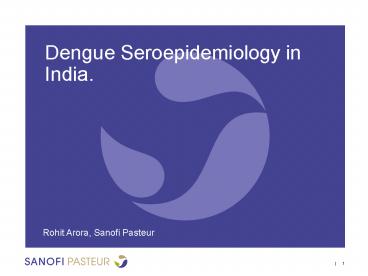Dengue Seroepidemiology in India. - PowerPoint PPT Presentation
1 / 13
Title:
Dengue Seroepidemiology in India.
Description:
Dengue Seroepidemiology in India. Rohit Arora, ... To determine the dengue virus serotype (DENV-1,2,3 and/or 4) specific to the antibodies in positive ... – PowerPoint PPT presentation
Number of Views:179
Avg rating:3.0/5.0
Title: Dengue Seroepidemiology in India.
1
Dengue Seroepidemiology in India.
Rohit Arora, Sanofi Pasteur
2
Dengue in the Past Quarter
- This map may be used as a guide for the
assessment of dengue risk throughout the world.
The blue regions represent areas of ongoing
transmission risk as defined by the Centers for
Disease Control and Prevention (CDC) based on
data from Ministries of Health, international
health organizations, journals, and knowledgeable
experts (last updated in 2010 for the 2012 CDC
Yellow Book). Recent reports (e.g., official,
newspaper, other media) of local and regional
dengue or imported cases of dengue collected by
HealthMap are shown as red markers linked to the
respective reports.
http//www.healthmap.org/dengue/index.php .
Accessed on 22/1/2012
3
Dengue Seroepidemiology in India
Decade wise circulation of various serotypes of
Dengue in published literature
All 4 serotypes of Dengue have been known to
circulate in the country since many decades.
Chakravarti A,, Arora R, Luxemberger S. Fifty
years of dengue in India. Transactions of the
Royal Society of Tropical Medicine (Under Review)
4
Active surveillance estimates of under reporting
in SEA countries
5
Under-reporting Large Scale, Multi-year School
based Active surveillance for Dengue in Southern
Vietnam
6
Surveillance estimates of under reporting of
Dengue in India
- Although Dengue is a notifiable disease, but
there is still a significant factor of
under-reporting. - It is often difficult to estimate the true factor
of under-reporting which may hugely vary due to
differential access to healthcare infrastructure.
- This is compounded further by the non-regulated
private healthcare setup where a substantial
number of cases go unreported.
Transactions of the Royal Society of Tropical
Medicine and Hygiene (2008) 102, 570577
7
Community-based dengue surveillance in India
(DNG09)
- Principal Objectives
- To estimate the population-based incidence of
symptomatic laboratory-confirmed dengue
infections in the catchment population of
selected cohorts across India (associated with
community centers) - Study design
- Prospective epidemiological study.
- Sample size
- During the determined period of data collection,
all patients presenting to the study sites and
fulfilling the inclusion criteria described below
will be enrolled. - Dengue Confirmation
- Detection of dengue viral RNA by
reverse-transcriptase polymerase chain reaction
(RT-PCR) will be performed in acute blood sample. - Serology by (ELISA) for IgG and IgM dengue
antibody.
8
The Challenges.
- Significant lack of population-based estimates of
incidence of laboratory confirmed dengue
infection. - Even areas with confirmed dengue reports and high
risk levels based on socio-demographic factors
have no documented data. - A retrospective investigation of morbidity data
in GIS mapped outbreak area revealed that dengue
was never diagnosed in any of the health centres. - Given this lack of previous accurate
documentation of dengue, a seroprevalence study
was planned - to assess the prevalence of dengue-specific
antibodies which will allow assessing if there
has been dengue transmission in the community in
recent years.
2007
9
Prospective dengue seroprevalence study in 5 to
10 year-old children in India.
- Most frequent diagnosis in these centres has been
of - Acute Respiratory Infection (ARI), and except the
respiratory signs, the other ARI symptoms (e.g.
fever, muscle aches, headache) are compatible
with a possible diagnosis of dengue. - A seroprevalence study was proposed, in a sample
of children registered in the health centres - to assess the prevalence of dengue-specific
antibodies which will allow assessing if there
has been dengue transmission in the community in
recent years (5 years). - Seroprevalence in children age between the age of
5 to10 shall be able to provide insight into
approximate average annual incidence of new
dengue infection over the last 5-10 years. - It was thought to additionally analyze
JE-specific antibodies in this population - To determine exposure of the Japanese
Encephalitis Virus (Flavivirus) in this
non-endemic area with close migratory connections
with endemic zones (eastern UP)
10
Prospective dengue seroprevalence study in 5 to
10 year-old children in India.
- Primary Objective
- To determine the prevalence of specific
antibodies (IgG) against dengue in healthy 5 to
10 year old children in India through IgG testing
using the commercially available kit "EL1500G"
from Focus Diagnostics (California, US) - Secondary Objective(s)
- To determine the dengue virus serotype
(DENV-1,2,3 and/or 4) specific to the antibodies
in positive (IgG) samples through PRNT50 - To estimate the prevalence of specific antibodies
(IgG) against Japanese encephalitis in healthy 5
to 10 year-old children in India through JE IgG
antibodies testing though Indirect ELISA using
commercial available kits (InBios, USA)
11
Prospective dengue seroprevalence study in 5 to
10 year-old children in India.
- Source and study population
- Children, 5 to 10 years of age, in India.
- Initially 2 study sites in Delhi. Is being
progressively be expanded to 10 sites across
India - For the two study site in Delhi, the population
is being drawn from children registered in health
centres invited to participate during household
visits performed by social workers of the health
centres. - Delhi Gate (Centre 001)
- Balmiki Basti (Centre 002)
- Dengue and JE antibodies testing is being
conducted in Department of Microbiology at
Maulana Azad Medical College, Delhi (Dr. Anita
Chakravarti)
12
Prospective dengue seroprevalence study in 5 to
10 year-old children in India.
- Sample size and power calculation
- This study is descriptive and therefore no
hypothesis is being tested. The sample has been
arbitrarily set at 323 subjects in each site. - Assuming a prevalence rate of 30, a sample of
323 subjects will ensure a precision of 5 for
the 2-sided 95 confidence interval around the
seroprevalence point estimate.
13
THANKS































